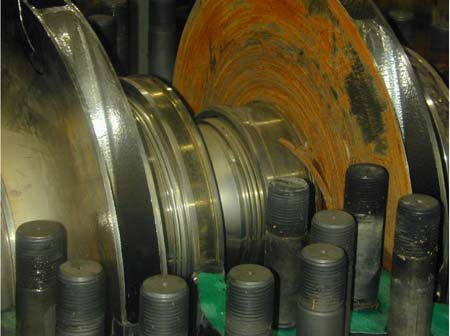Pumps & Systems
December, 2009
An 1,800 MW power station in the Midwest experienced constant trouble with four of its four-stage boiler feed pumps, which were driven by steam turbines and operated at variable speed to meet the required plant load.
According to the plant, these pumps had always exhibited high vibration. In 2003, the plant approached an aftermarket service provider to resolve this problem. Unfortunately, the pumps were not fitted with vibration monitoring equipment, so vibration trends were not readily available. Since the problem existed on all four pumps, a systematic analysis was recommended to determine the root cause. The plant and repair shop developed a plan to a) undertake a field study and conduct a vibration trend analysis, b) identify possible causes by performing hydraulic and structural analysis, c) analyze suitable modifications and d) rebuild the pump accordingly.
Field Observations
- The vibration level varied by machine, from 0.3 ips to a maximum of 0.7 ips.
- Maximum vibration levels were at one times running speed on the inboard bearing housing and two times running speed on the outboard bearing housing.
- The vibration level was ~0.15 ips at impeller vane pass frequency at five times running speed (the impeller had five vanes).
- In the past, the suction impellers were repaired or replaced every two years due to impeller vane erosion damage.
Analyses and Results
Engineers believed that the root cause for vibration problems could be attributed to the combined effect of structural stability and hydraulic phenomena. For the purpose of analysis both of these effects were studied separately.
Results of Structural Analysis
The recommendation was that the plant employ a third party consulting firm specializing in vibration analysis to conduct a field and analytical study to determine the full operating deflection shape (ODS) of the pumps. Impact testing was also performed to determine the natural frequencies and mode shapes of each unit. The ODS study revealed the following:
- Modal impact testing showed a lightly damped natural frequency of approximately 88 Hz on three pumps and 98 Hz on the fourth pump. As the typical running speed was between 4,400 rpm (73.3 Hz) and 5,400 rpm (90 Hz), the pumps were operating at or near critical speeds.
- Analysis showed that the one times running speed vibration was a result of the entire pump twisting on its pedestals, and not a result of localized motion of the bearing housings (see Figure 1). The pedestals were deforming their cross-sectional shape to produce this twisting motion. The inboard bearing housing moved in-phase with the barrel at this frequency. Applying a fix to the coupling guard or inboard bearing housing could slightly reduce vibration levels, but did not address the vibration’s root cause.
- The outboard bearing housing vibrated in the vertical direction at two times running speed due to a nearby vertical natural frequency of the outboard bearing housing. In some cases, the amplitude of this vibration exceeded that of the one times vibration on the inboard bearing housing.
- The outboard bearing housing vibrated in the horizontal direction at vane pass frequency (five times running speed = 375 Hz to 450 Hz). There was a natural frequency at approximately 380 Hz that produced at least some significant vibration over this entire speed range.

Figure 1. Data acquired during testing shows the pump twisting on its pedestals.




